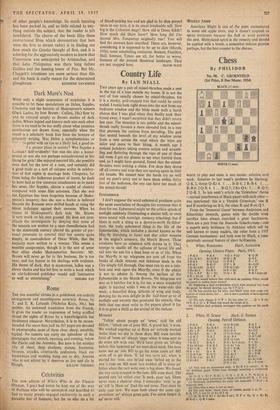Chess
By PHILIDOR No. 98. C. GROENVELD (1st Prize, II Due Mosse, 1954) BLACK (I I men) WHITE (7 men) WHITE to play and mate in two moves: solution next week. Solution to last week's problem by Hartong: Q-K 2, threat Q-Kt 4. 1 . B-B 6; 2 R-B 4. 1 ...
R-B 6; 2 Q-K 4. 1 B-Q 5; 2 Kt-Q 6. I R-Q 5; 2 Q-K 5. In last week's article the 'Grimshaw' theme —mutual interference of Black pieces with each other— was mentioned: this is a 'Double Grimshaw,' one R and B interfering on B 6, the other R and B on Q 5.
From the 'Immortal Game' between Andersson and Kieseritzky onwards, games with the double rook sacrifice have always exercised a great fascination. Here are a pair from the Deutsche Schachzeitungona a superb early brilliance by Alekhine which will bo well known to many readers, the other from a 1957 German tournament: and both won by Black, a 00/12- paratively unusual feature of short brilliancies.
I. White, RODZINSKI Black, A LEKHINS . Opening, Giuoco Piano. Paris, 1913.
P-K 4 P-K 4 9 Q x P (e) K-Q 21
2 Kt-K B 3 Kt-Q B 3 10 Q x R Q- B 5
3 13-13 4 P-Q 3 (a) I I P-I3 3 B x PI 4 P-B 3 B-Kt 5 12 P x B Kt-Q SI S Q-Kt 3 (6) Q-Q 2 13 P-Q 3 (d) Q x P
6 Kt-Kt 5 Kt-R 3 14 P x Kt B-K 21 7 Kt X P Kt x Kt 15 Q x 13- R 5 mate(*) 8 B x Kt ch Q x
(a) Who would believe that with such an opining White would be mated in twelve more moves?
(b) Beginning a fatal combination which wins material but loses the game: he should develop, e.g. by 5 P-Q 3.
(c) He has carried out his plan, and Black must now come out a pawn or more down, but this is not u position to have agaitut Alekhine. (d) His only chance is 13 P x Kt but after 13 . . Q x B ch; 14 K-K 2, Q x R Black has much the better of it.
(e) Alekhine had probably envisaged this position on his ninth move.
(a) First step on downward path. 8 Kt-0 3 is correct. A' in the Alekhiue game. White loses through launching a premature
attack.
(6) 14 Q x Kt P. R-Kt I; 15 Q x P. R x P; 16 Kt-K 4, Q-K. 4; with great advantage to Black (17 R x Pt hl). CO Obviously overlooking the reply: the miserable 17 B-Q I is
relatively best. (d) Otherwise a piece is lost at once,
(e) The only hope: Black must, of course, accept it as 20 . K-K 2??: is met by 21 Kt-Q 5 ch. (r) Or 26 R-Q Kt Kt-Kt 6 chl; 27 P x Kt, Q x Kt Pg 28 8-Q 1, Q-R 6 mate. 2. White, H. SCMID Black, E. RIEHLB Opening, Petroff Defence.
I P-K 4
. 2 Kt-K B 3
3 Kt x P 4 Kt-B 3
5 Q-K 2 6P-Q3
7 B-Kt 5
8 Kt-Q 4 (a)
9 Kt x B 10 B x Kt II Q-R 5 ch 12 Q-Kt 5 ch 13 Kt-B 3 P-K 4 Kt-Q-K3 B 3 P Kt x P Q-K 2 Kt-11 3 B-K 3 P-K R3 1' x Kt Q
K-Q 2! Kt-B3 P-R 3 14 0-13 4 (6)
15 B-K 2 16 Q -K 4 17 0-0-0 (c) 118 R 4 19 R--Q 2(d)
20 Kt- Kt 6 ch (e) 21 Q Kt 7 ch 22Q x R cb
23 Q R
24 K-Kt 1
25 K-R I
26 B-R 5 (f) 27 p x Kt B-K 2 P-Q Kt 4 Kt-Q 5 P-Kt 5 Q-I3 5 chi B-Kt 4
P x Kt K-Q I K-K 2
Q x 12 eh Qx Pan B-B 31 Kt-Kt 6 eh Q x P mato


































 Previous page
Previous page